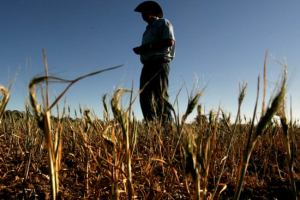Crippling drought conditions in eastern Australia are expected to wipe millions of tonnes off winter crop production this year and rainfall forecasts suggest “limited” prospects for summer crops, a new report has warned.
On Tuesday a report from the federal agricultural department revealed the winter crop production in New South Wales would be almost cut in half on the year before.
The report revealed crop levels in NSW, Queensland and Victoria was forecast to decrease by 46%, 38% and 29% from 2017, because of “unfavourable seasonal conditions” in most parts of eastern Australia.
The report, from the Australian Bureau of Agricultural and Resource Economics and Sciences, predicts overall winter crop production will be 9% lower than the 20-year average.
But farmers have warned that the forecasts in the report may actually be optimistic.
The chairman of the grains committee of the New South Wales Farmers Association, Matthew Madden, said that while the crop forecasts were shocking, the continued lack of rain since the report was compiled meant the situation was likely worse.
“My assessment since then is that production will be lower than what they have predicted,” he said.
The new report comes amid serious drought conditions, particularly in NSW. In August, the Department of Primary Industries revealed that 100% of the state was in drought conditions.
Earlier this month the Guardian revealed consistently low rainfall meant water flows into the Sydney drinking catchment were at a record low and less than half of what they were during the millennium drought last decade.
Madden, a grain grower from east of Moree, said that his crop was between 30% to 40% lower than usual, “but that’s a lot better than a lot of people”.
“A lot of people in our district have nothing [and] didn’t plant at all this season,” he said. “You start to see the flow-on effects in a community pretty quickly. The farmer obviously has a much reduced income but it also has effects into the town. Farmers have employees who may or may not have to be put off, who stop spending money.
“That flow-on effect is quite devastating for a town and for a grain growing district the reality is it will be 12 months until the next time a farmer will have a significant income.”


